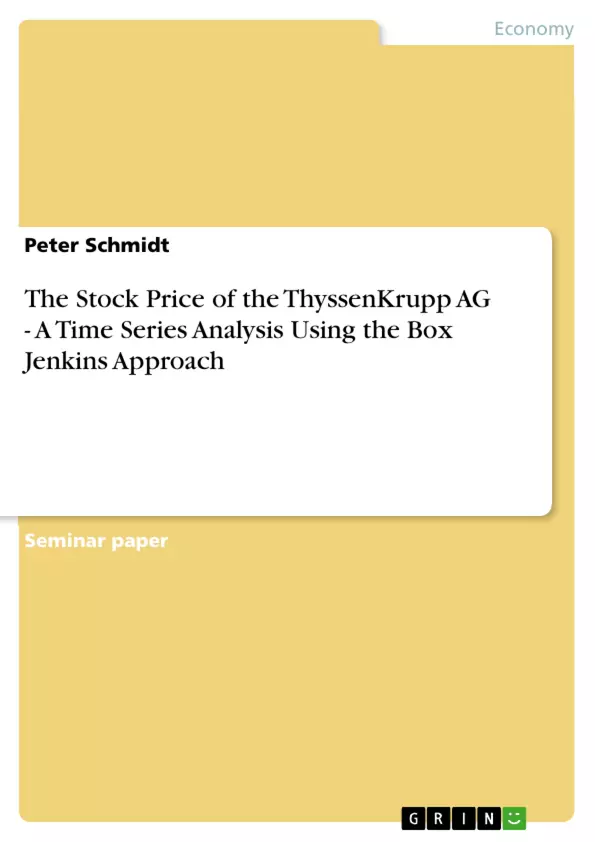In this paper the Box- Jenkins forecasting technique should be applied to the stock price of the ThyssenKrupp AG. ThyssenKrupp arose from the merger of the “Thyssen AG”
and the “Friedrich Krupp AG Hoesch-Krupp” in 1999. The main focus of the trust lies on steel, industrial goods and services with its five sections Stainless, Steel, Technologies, Elevator and Services. With 191,350 employees in over 70 countries and a turnover of 51.7 billion Euro p.a., ThyssenKrupp is one of the largest industry and technology groups in the world. At the same time it is Germany’s biggest steel and armaments manufacturer. I chose the stock price of the ThyssenKrupp trust for several reasons. First, it is a blue chip listed on the stock exchange since 1999 allowing me easy access to a sufficient and reliable
amount of data. Second, I have no reason to believe that this trust underlies any influence of seasonality since it has so many different segments that contribute to its economic
performance. Third, since the steel demand and thus prices are steadily increasing in the last years it is not surprising that the stock price of the ThyssenKrupp AG does this too (see
figure 2 further down) giving me a reason to question financial market theories. In particular, financial investors and researches are very often interested to predict future
values of stock prices. On the one hand they do so, to gain profits from investing in stocks from buying at a low price and selling at a higher price and on the other hand to verify if
financial markets work efficiently. For the latter reason, financial research for a long time believed stock prices to follow a random walk and thus that prices of the stock market
cannot be predicted2. This implies that financial markets are at least weak form efficient and excess returns cannot be earned by using investment strategies based on historical shareprices, i.e. time- series analyses can not be used to predict future values of stock prices. In this paper I will try to find out if the stock price of the ThyssenKrupp AG follows a random walk or not using the Box-Jenkins forecasting approach. For my analysis I use the weekly opening stock price starting at 01/01/2003 and ending at 04/21/08 and thus I have 278 observations. To analyze the data I use the software STATA (version 9.1.).
Table of Contents
- Introduction
- The Box-Jenkins-Approach
- Modeling A Stationary Time Series For The Stock Price Of The ThyssenKrupp AG Using The Box-Jenkins-Approach
- Test for Stationarity
- Postulate a General Class of Models
- Identification of an Adequate Model
- Estimation and Diagnostic Checking
- Validation and Forecast
Objectives and Key Themes
This paper applies the Box-Jenkins forecasting technique to the stock price of ThyssenKrupp AG to determine if the stock price follows a random walk. The analysis uses weekly opening stock prices from 01/01/2003 to 04/21/08.
- Application of the Box-Jenkins approach to time series forecasting.
- Analysis of the stationarity of ThyssenKrupp AG's stock price.
- Model identification and selection for the stock price data.
- Evaluation of the forecasting accuracy of the chosen model.
- Testing the efficient market hypothesis through prediction of stock prices.
Chapter Summaries
The introduction establishes the context of the study, explaining the choice of ThyssenKrupp AG and the rationale behind using the Box-Jenkins approach to analyze its stock price. It also provides background on the efficient market hypothesis and the limitations of traditional stock price prediction methods. The Box-Jenkins approach section provides a brief overview of this time series forecasting method, emphasizing its theoretical foundations and practical applications. The third section details the application of the Box-Jenkins approach to ThyssenKrupp's stock prices, outlining the steps of stationarity testing, model identification, estimation, and diagnostic checking—but stopping short of the conclusion and forecast validation.
Keywords
Box-Jenkins approach, time series analysis, stock price prediction, ThyssenKrupp AG, stationarity, ARIMA model, efficient market hypothesis, forecasting.
- Quote paper
- M.A. Peter Schmidt (Author), 2008, The Stock Price of the ThyssenKrupp AG - A Time Series Analysis Using the Box Jenkins Approach, Munich, GRIN Verlag, https://www.grin.com/document/121797



